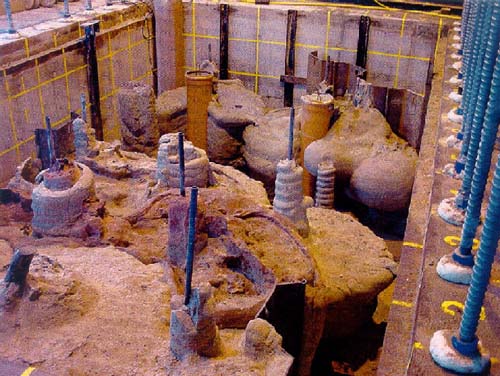Investigation for assessing the effect of heterogeneity in non-cohesive soil on DSV sealing slabs

As part of a research project the Chair for Soil Mechanics and Foundation Engineering / Geotechnical Engineering - deals with the question under which conditions defects in sealing slabs produced in the jet grouting process may result from obstructions in non-cohesive soil.
Low-pitched excavation in the floor area must be sealed against pressurized groundwater. Due to the strict regimentation of residual water rates (e.g. in Berlin: Permitted qr = 5.4 m³ / h per 1000 m² wetted area) must be a good seal of the pit guaranteed regardless of water pressure difference and sole construction. In recent years, not only by the prohibition of the production of soft gel in Berlin - sealing slabs in grouting (DSV) has grown in importance. In this process, also called high pressure injection (HDI), a high pressure (over 400 bar) is pressed with a water-binding agent suspension over a rotating drill string laterally into the ground. The suspension hardens and mortared thereby the surrounding soil.
By all sole structures for the transmission not the sole homogeneous manufactured parts are important but the defects are crucial. Apart from the methodological factors are important reasons for the water permeability of sealing slabs in the heterogeneity of the soil to seek. These are themselves through extensive preliminary investigations not clearly detectable. Even small differences in soil structure can cause damage with far-reaching consequences. For example, obstacles, geological and anthropogenic origin, obstruct an ideal training of the DSV body. Especially in Berlin buildings have always unpredictable damages trough nozzles Chat formation (e.g. boulders) and occurred by inclusions of charcoal in HDI soles. Costly repairs were required and attracted considerable cost to themselves.
In a large-scale trial in the Chair's own test facility, a typical soil situation was simulated. In a 28 m² experimental field were obstacles of various kinds (coal, wood, clay layers, boulders, piles, pipes, etc.) This happened in different depth of built into a dense medium sand and their location were mapped. Accompanied by a comprehensive measurement and analysis program DSV cylindrical body were (up to 2.50 m high, 1.50 m diameter, partially overlapped) with defined parameters and exposed after hardening. The results of these studies will help to identify problems in the production of DSV-resistant soles early - in order to take appropriate countermeasures in a good time and to develop appropriate controls just to prevent damage claims.
Markus Kügler
life:
2000 - 2002
